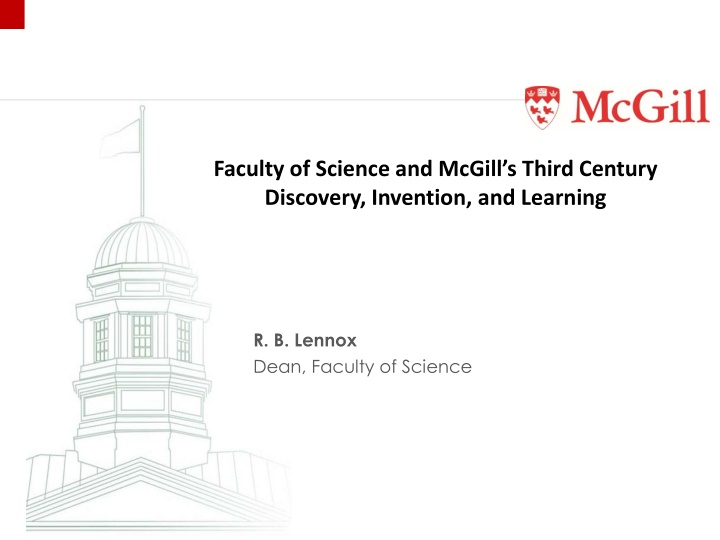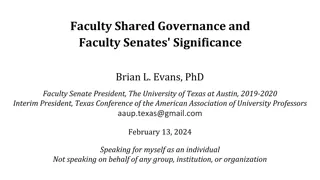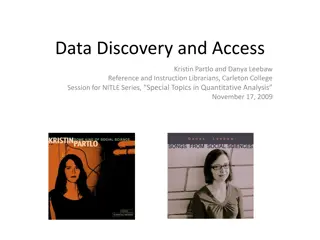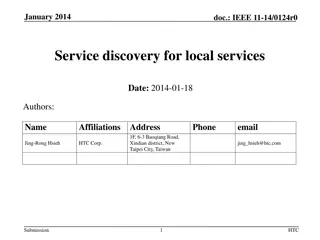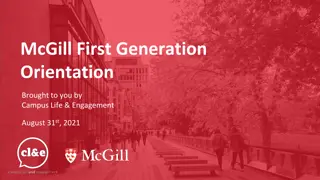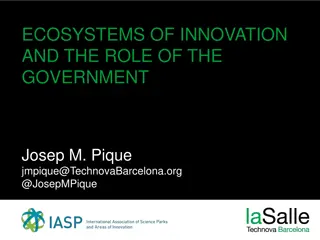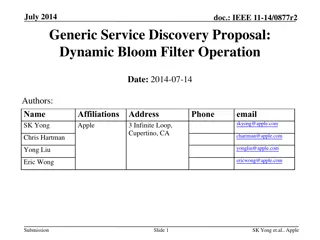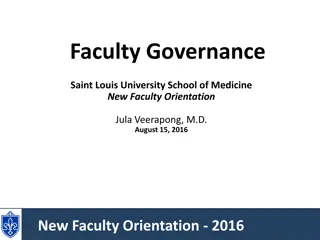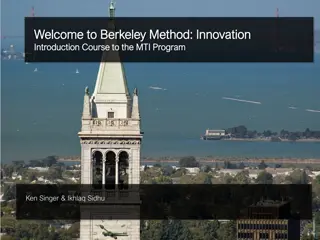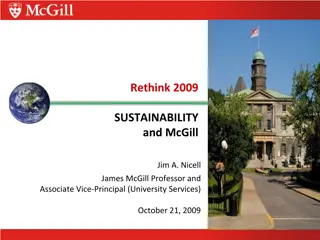McGill's Faculty of Science: A Legacy of Discovery and Innovation
Explore the rich history and promising future of McGill's Faculty of Science, highlighting key figures, strategic planning frameworks, and academic priorities. Witness a tradition of impact in science and education, rooted in a legacy of exemplary scholars and innovative initiatives.
Download Presentation

Please find below an Image/Link to download the presentation.
The content on the website is provided AS IS for your information and personal use only. It may not be sold, licensed, or shared on other websites without obtaining consent from the author.If you encounter any issues during the download, it is possible that the publisher has removed the file from their server.
You are allowed to download the files provided on this website for personal or commercial use, subject to the condition that they are used lawfully. All files are the property of their respective owners.
The content on the website is provided AS IS for your information and personal use only. It may not be sold, licensed, or shared on other websites without obtaining consent from the author.
E N D
Presentation Transcript
Faculty of Science and McGills Third Century Discovery, Invention, and Learning R. B. Lennox Dean, Faculty of Science
McGill Science Who we are in 2019 10 departments, 265 professors, and 160 staff 4900 undergraduates, 1070 graduate students, 205 postdoctoral fellows 5 affiliated departments with an additional 130 professors and 140 staff 2
Science and McGills ThirdCentury Discovery, Invention, and Learning McGill s 1st Century- Ernest Rutherford, Harriet Brooks, Frederick Soddy, Carrie Derrick, William Dawson . McGill s 2nd Century: Ron Melzack, Bernard Belleau, Kelvin Ogilvie, D.O. Hebb, T.H. Clark .. McGill s 3rdCentury? : . A remarkable tradition of impact in Science combined with the Teacher-Scholar model in the past and present, and poised for the future 3
Strategic Planning Frameworks and the Faculty of Science McGill Strategic Academic Plan 2017-22 Principal s Priorities McGill Strategic Research Plan 2017-22 2019-25 Faculty of Science Strategic Academic and Advancement Plan Royal Vic Academic Plan Bicentennial Campaign 2016-26 2018-2026 4
Strategic Planning Frameworks The McGill Academic Plan is based on the 3 Core Ideas of the Principal s Priorities : McGill University is Open, Connected, and Purposeful Open to new ideas, other ways of looking at the world; open to cultural and human diversity; open to new ways of doing things; Connected to its local and global community; connected across disciplines, boundaries of geography and sectors; and Imbued with a clear sense of purpose, because what we do learning, using and advancing knowledge, exploring new paths in knowledge has never mattered more to our community and our world. 5
McGills Strategic Academic Plan These 3 Core Ideas are expressed within the Strategic Academic Plan s 5 Themes Be open to the world Lead innovation Expand diversity Connect across disciplines and sectors Connect with our communities 6
Discovery, Invention, and Learning in the 21st Century The Systems Science Approach at McGill An interdisciplinary approach that recognizes that highly complex problems emerge at the interface of multiple scientific and social systems Complex systems are ones that are interconnected to neighboring systems and their perturbations and are often described as wicked problems ; a wicked problem is a social, scientific, or cultural problem that is difficult or impossible to reduce to one solution because many problems are interconnected to other problems Systems Science often requires sustained collaboration across scientific disciplines and sectors (govt, business/industry, legal/regulatory) in order to promote new creative approaches that will be effective in the idea-to-implementation continuum For illustration purposes, Sustainability is excellent example of the power and reach of Systems Science: Sustainability Systems involve, for example, pure and applied biologists, environmental scientists, climatologists, materials scientists, and chemists who work in concert with policy experts, legal scholars, and government and industry leaders to create effective and practical solutions to threats to societal and cultural security A commitment to Systems Science leads to new discoveries and new technologies, provides a template for training the next generation of scientists, public leaders, and business leaders, and serves as a catalyst for new ways of thinking, teaching, and discovering both within McGill and beyond. 7
Discovery, Invention, and Learning in the 21st Century: The McGill Systems Science Institutes and Laboratories Two new structures will be integral to the McGill Systems Science approach Institutesand Laboratories: Institutes organizations which enable the integration of research problems outside the discipline-specific structures (departments) Laboratories physical and/or virtual spaces where ideas are synthesized and matched to problems, concepts tested, successes built upon, failures learned from and adapted to above all, a place where creativity is promoted and tested Institutes and Laboratories transcend common disciplinary organizational structures and enable integration, allowing researchers to work and think in a space that they might not formally belong in, or traditionally have the credibility work in Institutes and Laboratories willpromote the construction of a wiring/circuit diagram between fields and problems .. leading to a Connectome of Science Departments(Physics, Geography, Chemistry, etc.) will be sustained and improved upon in parallel as they are the backbone of the disciplinary organization of teaching and learning; professors will concurrently be members of Departments and Institutes/Laboratories 8
SystemsInstitutes and the Measurement Innovations Laboratory are expressions of the interconnections found in research problems . Molecule- Materials Systems Inst Earth- Planetary- Space Systems Inst Conitive Systems Inst Measurement Innovations Laboratory Comput al BioSystems Inst Data Science Systems Inst
whereas Departments are expressions of the organization and rigor of discipline-defined teaching and learning of Science, supported by the Science Education Innovations Laboratory .. Chemistry Biology Physics Atmospheric & Oceanic Science Education Innovations Laboratory Maths and Stats Geography Computer Science Psychology
and the combination defines the McGill Science Connectome Institutes + Measurement Innovations Lab Chem Biology Physics Atmospheric & Oceanic Earth & Planetary Sciences Geography Maths and Stats Computer Science Psychology Depts + Science Education Innovations Lab
The Royal Vic and the Faculty of Science .. McGill Strategic Academic Plan 2017-22 Principal s Priorities McGill Strategic Research Plan 2017-22 2019-25 Faculty of Science Strategic Academic and Advancement Plan Royal Vic Academic Plan Bicentennial Campaign 2016-26 2018-2026 12
T THE HE A ACADEMIC CADEMIC P PLAN LANFOR FORTHE THE R ROYAL OYAL V VIC IC Max Bell School of Public Policy (45 principal investigators) An enduring and inclusive prosperity including social well-being Canada's place in the world including responsible development of the North The energy-environment nexus transition toward low-carbon technologies Democratic institutions response to economic and social landscape Canada's economic resilience response to globalisation Sustainability Systems (135 principal investigators) Earth Systems: Sustaining landscapes for the future climate change, biodiversity, water management, land use Molecular & Materials Systems: the design, development, evaluation and use of sustainable materials and processes Urban Systems: making cities more inclusive, environmentally, socially and economically sustainable and healthy atmospheric and oceanic sciences | economics | earth and planetary sciences | mechanical engineering | sociology | chemical engineering | geography | political science | electrical engineering | materials science | mining and materials engineering |urban planning | architecture | civil engineering | chemistry | physics
RVH SITE (PRESERVEDBUILDINGSANDPLANNED) WOMEN S ROSS 690M$ RVH Total Cost : Funding sources : Provincial (Qc) Federal McGill 465M$ 75M$ 150M$ HERSEY McGill future construction 690M$ Soci t qu b coise des infrastructures (SQI) McGill new construction McGill Academic Pavilion - patrimonial portion Page 14
MCGILLATTHE ROYAL VIC SITE Total area on the Vic site: 110,000 m2raw space Area for Academic Plan, Phase 1a: 50,000 m2raw space Total capacity: 6,000+ Major research activities: 180researchers and 400 university staff 1,700 graduate students and postdoctoral fellows 350 undergraduate students Supplementary teaching areas: 2,000 undergraduate students from all over the campus will enjoy the active learning classrooms and teaching labs. Phase 1b will add 42 additional researchers, about 70 university staff and 350 graduate students and postdoctoral fellows. Page 15
Measurement Innovations Laboratory VISION Create a unique capability for scientific discovery in a multitude of fields by inventing, designing, and applying new instrumentation and tools for measurement, data analysis, and fabrication MISSION McGill Science will be a world leader in the invention, development, and use of new scientific tools, where tools are defined as measurement and methods platforms or systems (including new software and analysis methods) which have the potential to advance scientific knowledge and understanding OVERVIEW AND CONTEXT Discovery in science has very often been enabled by new measurement tools; McGill researchers have often demonstrated the validity of Freeman Dyson s insight that The effect of concept- driven revolution is to explain old things in new ways. The effect of tool-driven revolution is to discover new things that have to be explained Every time we introduce a new tool, it always leads to new and unexpected discoveries, because Nature s imagination is richer than ours. New tools have led to major advances in physical, applied, and biomedical sciences as reflected in examples such as scanning probe microscopy for imaging of materials on the atomic scale, MRI for imaging of pathological states in living organisms, and PCR for the amplification of minute quantities of DNA for research and forensic purposes. Examples of new tools under current invention/development at McGill Science include detectors applied to high energy physics and astrophysics; molecular biology markers of genetic diseases; ultra-high resolution microscopes using optical, probe, and physical properties; computational platforms for materials design; ultrafast spectroscopy to probe structure -property relationships in quantum materials. 16
Science Education Innovations Laboratory VISION Create a unique capability for the development, implementation, and promotion of science teaching and learning at the undergraduate level MISSION McGill Science will be a world leader in the development of teaching innovations in an ecosystem of like-minded instructors with the goal is to enable a student to identify, define, and address scientific problems and in doing so, embrace the challenge of complex problems. OVERVIEW and CONTEXT Undergraduate education involves lecture, laboratory, and experiential/research-oriented experiences throughout a BSc program; teaching innovations have previously been undertaken by units and/or instructors working in isolation from one another. Innovations in teaching must mirror students technological sophistication and desire for their teaching/learning experience to be as impactful as the subject matter they are studying. The learning of Science in the next decades requires innovations in course delivery, assessment methods, and content. McGill Science has frequently demonstrated that innovations such as active learning and integrated experiential learning are effective in developing a student s critical analysis skills while also enabling them to develop as disciplinary experts. Outreach and Inreach can be platforms for the development of students essential communication skills while also creating community engagement responsibility. The Science Education Innovations Laboratory in partnership with TLS and the Faculty of Education will create an ecosystem for the incubation of new teaching /learning/outreach programming. 17
Computational/Data Science Systems Institute VISION Create a unique capability that enables the discovery and application of new computational, mathematical, statistical, and data science methods MISSION McGill Science will be a world leader in the development of data analyses methods and algorithm innovations, the mathematical and statistical foundations of these innovations, and their application to complex physical, biological, and social sciences problems. OVERVIEW and CONTEXT Computational/Data Sciences are now integral to all aspects of personal and public enterprise, rather than being just tools and communications enablers; some 90% of World s data was created in the past 2 years and the growth rate is 40% p.a. - resulting in Data Science becoming central to decision-making in all sectors, including research There is a critical, emerging need for analytical training and tools that can enable researchers to integrate and manage those datasets to transform information into knowledge Researchers in all areas of Science rely on quantitative and computational procedures due to the vast quantities of experimental data that are now being produced The great advances in instrumentation, combined with great increases in raw computing capability, are vastly increasing the ability of researchers to convert observations and data into knowledge and decisions in fields as far-ranging as particle and cosmological sciences, molecular biology, systems biology, climate science, and physical geography. 18
Cognitive Systems Institute VISION Create a unique capability to discover and understand the nature of human cognition, how this knowledge can be applied to the development of artificial intelligence, and how human mental processing and artificial intelligence can work in concert MISSION McGill Science will be a world leader in the integration of multiple levels of analyses in Cognitive Systems, from the molecular to the social/cultural, in order to increase the explanatory value, predictive power, and applicability of Cognitive Science theory. OVERVIEW and CONTEXT The range of analyses includes the neuronal bases of mental processing, how intelligent systems operate, how intelligent systems interact, how context modifies intelligent operations, how cognition is motivated, and what the downstream consequences are of finely tuned intelligent operations and dysfunctional operations. Application of the theme Thinking is for Doing will enable access to vast amounts of data from mobile sensing applications and social networking sites combined with AI or ML. (machine learning) analytical resources will enable researchers to examine human thought and behavior naturalistically and on a broad scale within the many contexts of daily life. A Systems approach will enable the development of new insights to research problems. associated with discipline-based sectors such as human communication disorders, linguistics, psychology, computer science, biology, education, philosophy, and psychiatry and sub- discipline specialties such as machine learning, computer vision, and human-computer interactions. 19
Earth-Planetary-Space Systems Institute VISION To create a comprehensive, quantitative, and predictive model of interactions between land, oceans, and atmospheres within the Earth Systems and to develop a detailed understanding of the origins and subsequent evolution of the Universe MISSION McGill Science will be a world leader in the development of the theoretical and experimental capabilities that are required to solve some of the great unknowns of Earth Systems and the Universe including details of the early universe, the inter-relationships between theoretical, experimental, and observational cosmology, the nature of climates and atmospheres of planets, and the search for non-terrestrial life. OVERVIEW and CONTEXT McGill's Earth - Planetary Space Systems research has unique access to a global network of measurement capabilities, ranging from remote sensing capabilities, to a network of North Pole-to-South Pole research stations, to state-of-the-art radio telescopes around the World. The development of computational models of the interface between the Earth s surface and atmosphere, planetary atmospheres, to the history and future of the Universe is enabled by the ecosystem of computational and data science. The Systems approach will inform policy makers, stakeholders, and the public as to the best strategies for development, urban growth, biodiversity conservation, and climate forecasting. 20
BioSystems Institute VISION To create an understanding of the structure and dynamics of life from molecular to global scales and to link this understanding to the emergence and functioning of one large system of life on Earth that arises from the integration of these subsystems. MISSION McGill Science will be a world leader in the integration of biophysics, biochemistry, ecology, cell biology, neurobiology, and evolutionary biology research in order to understand the interconnections and interdependencies between molecules, cells, organisms, and the ecosystem at/of each scale. OVERVIEW and CONTEXT The principles of Systems Science are well established within many sectors of Life Sciences; at the core of Life Science Systems is the problem of scale, requiring a resolving of the functioning of biological systems across all levels of biological organization. Partnership with the Computational/Data Systems Institute will enable application of mathematical, computational, and statistical methods to achieve an integration of the study of biological systems across scales, from single molecules to the environment, leading to interfacing with bioinformatics, biophysics, medical informatics, and computational biology. The universal scope of the BioSystems Institute will enable the development and application of novel methods to address the most pressing biological and biomedical challenges. 21
Molecule-Materials Systems Institute VISION To create the theoretical, experimental, and computational methods that enable the design, synthesis, understanding, and control of the function of molecules and materials MISSION McGill Science will be a world leader in integrating physical, biological, and computational research to comprehensively understand the relationships between atoms, molecules, and materials in order to rationalize observed functional properties (such as quantum effects, (self) recognition and assembly in biological materials, or macroscopic phenomena such as viscosity, elasticity, and hardness) and to predict unrealized properties. OVERVIEW and CONTEXT An understanding of the properties of matter on lengthscales from the sub-atomic to the macroscale is central to the development and use of virtually all modern processes and technologies. Molecule-Materials Systems encompass the study of isolated atoms subjected to intense magnetic or electro-optical fields, to molecules that organize in specific manners to create biological function, to materials and their interactions with the environment and ecosystems. Partnerships with the Instrumentation Innovations Laboratory will lead to the discovery of new properties of molecules and materials and with Computational/Data Sciences Systems Institute will enable the application of mathematical and statistical methods, computational modelling, and Artificial Intelligence/Machine Learning methods to predict the properties of in silico- designed molecules and materials. 22
McGill Science Connectome: A complete mapping of the structural and functional connections that exist in 21st Century Science Institutes + Measurement Innovations Lab Chem Biology Physics Atmospheric & Oceanic Earth & Planetary Sciences Geography Maths and Stats Computer Science Psychology Depts + Science Education Innovations Lab
Next Steps.. Discussions at Departmental and Faculty levels of Institute and Laboratory models Information sessions re: Royal Vic academic planning and fit/design Charter statements and development planning for each Institute and Laboratory with a series of Working Groups Identification of leadership groups associated with each Institute and Laboratory 24
Some comments and reflections. None of the text in the foregoing has derived from any consideration of branding/marketing. Ideas welcome. - Nomenclature? (Institutes? Networks? Clusters? Laboratories?) Each Institute and Laboratory has deep innovation/ entrepreneurship opportunities; each will aim to have its own research partnership officer/facilitator/Professor-of-Innovation The themes selected reflect the Faculty in 2019 and for the foreseeable future. New Institutes and Laboratories will arise as new themes emerge and science continues to shift
Some Anticipated Questions Institute Vision Why Institutes? What do they enable that department structures don t already do/accomplish? Why would they work? When will this all start? What will be the first Inst? What is the governance model and who is going to lead these Institutes? Who belongs to an Institute, and how do they initiate membership? What if a faculty member is not a member of an Institute how does this affect their research? Can non-Science faculty be members of a Science Institute? Institute and Laboratory Operations Where will Institutes physically be located and what will their their admin structure? Will we need more staff to operate these institutes? How is academic/professorial hiring going to work? Do the Laboratories belong to an Institute or Institutes?
Departments- Operations What will the role of Department Chairs be? What kind of impact will Institutes have on the departments in both Admin and Academic terms? Who will do graduate student admissions? Space. How will this work? Who controls what? How will research financial services work? IT responsibilities in Institute model? How much more work will these institutes generate/create for a department
